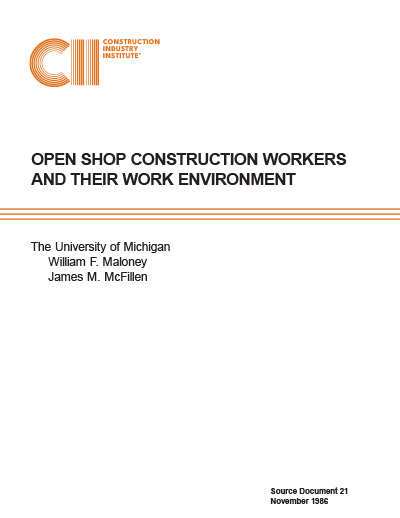
Employee Involvement in Construction
The construction industry in the United States has been suffering from declining or stagnant employee and organizational effectiveness. Productivity, quality, safety, and other measures of performance have not improved significantly or at all over the past twenty years. Unlike manufacturing in which the rate of production may be machine determined, the rate of production in construction is determined by the individual or group of individuals performing the task. Historically, construction firms have been preoccupied with control. Jobs are planned and estimated in great detail, schedules developed to allow tight control, narrow work rules created, tasks sub-divided to reduce training time and increase proficiency, workers never let in on decisions, and no consequential information about the business or work shared with the workers. The goal appears to be to engineer the worker out of the job. In doing so, managers are attempting to reduce the variability or uncertainty in performance. To do this, management employs a traditional scientific management approach to the organization of work. Each job is divided into finite tasks, the “optimal” method of performing each task is identified, workers with the necessary skills for the task are hired or are trained in those skills, and the performance of the job is closely monitored to ensure that the prescribed method is followed. Thus, uncertainty and variability of performance are reduced.
The problem with this approach is that the skills and abilities of the workers are never fully tapped. Variability in performance is reduced, but the opportunity for significant improvement in performance is foregone because the knowledge of the workers is not used in planning the work. Workers are hired as a strong back and a pair of hands. The extent of employee involvement is for the workers to listen to management directives and respond “Yes Sir!”
The opposite of this approach is for the workers to be members of self-managing work teams in which the workers elect their own leaders, determine how the work is to be done, and plan, schedule, and control the work. In addition, the workers manage the members of the team to ensure appropriate behavior is exhibited. The knowledge of the workers is fully utilized. However, for this to take place, management must relinquish some control.
Construction is a labor intensive process. Consequently, the performance of a construction task is a function of the motivation of the workers performing the task. Worker motivation has been found to be directly related to the involvement of the workers in the task. Employee involvement has been found to result in improved productivity, improved quality, lower absenteeism, and lower turnover. Little is known of the utilization of employee involvement in the construction industry in the United States and the benefits derived from that involvement. If employee involvement is to be seriously considered, there is a significant need for an analysis of employee involvement and the potential for its utilization in construction. The analysis, which must develop an understanding of employee involvement and its costs, benefits, limitations, and constraints, is important to construction organizations as they attempt to develop human resource management strategies to improve their cost effectiveness.



